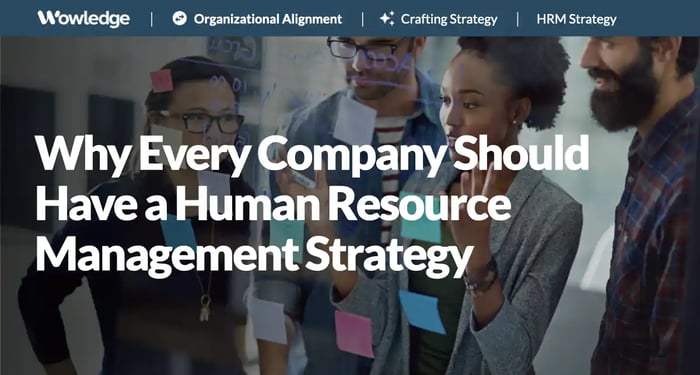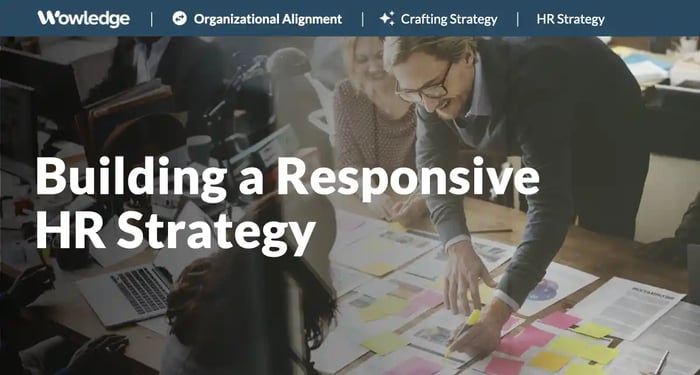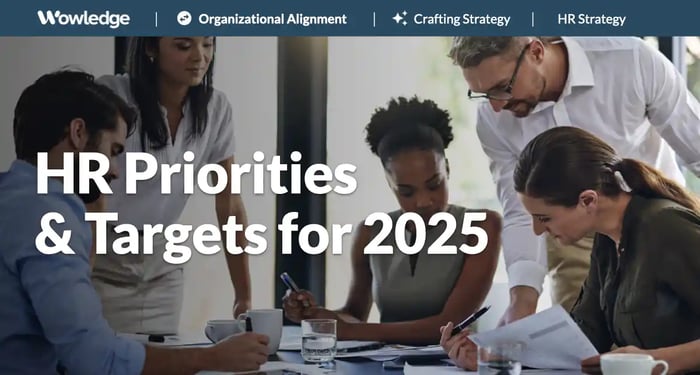Table of Contents
As the business landscape continues to evolve and shift, Human Resources (HR) leaders find themselves at the forefront of many challenges, necessitating a proactive approach to prepare for what lies ahead in the coming year. As we at Wowledge have written on the power and need for robust HR strategies and plans, the issues organizations currently face can appear overwhelming. As a result, preparing HR priorities for the current environment is an essential element of business planning that is called out as a major priority.
The current intersection of economic dynamics, labor market fluctuations, and skill shortages continues to shape the contours of the modern workplace. Against the backdrop of a post-pandemic recovery, HR professionals must navigate a situation in which demand for certain skills outstrips the available talent pool, requiring innovative recruitment strategies and reskilling initiatives. Concurrently, the evolving nature of workspaces and schedules, influenced by the surge in remote and hybrid work models, is prompting HR leaders to reevaluate traditional norms and establish adaptable frameworks that prioritize employee well-being and engagement.
Added pressures are created by the rapid emergence of generative Artificial Intelligence (AI). While it promises to reshape how work is conducted in the long run, HR leaders must start grappling with ethical considerations, privacy concerns, and the imperative to cultivate a workforce capable of collaborating seamlessly with AI counterparts now. Additionally, the socio-technical implications of AI adoption on workplace dynamics require that leadership fosters a culture of continuous learning and innovation.
Beyond technology, HR leaders increasingly recognize their critical role in addressing the escalating challenges posed by climate disasters and the likelihood of impacts on company operations, employee well-being, and the communities in which they conduct business. As climate change intensifies, companies must strengthen their proactive and reactive strategies, incorporating health and safety measures, sustainable practices, and cultivating an environmentally conscious workforce. The convergence of economic, technological, and environmental trends underscores the landscape that HR leaders must navigate in 2024, demanding a forward-thinking and adaptable approach and preparing HR priorities to meet the evolving needs of the workforce and the broader business ecosystem.
Trends impacting HR strategies
Macroeconomic
As always, Wowledge continues to beat the drum for HR leaders and professionals to understand and respond to external forces that impact their organization’s ability to meet its goals and objectives. After years of low interest rates and cheap money for investment, central banks have raised rates substantially to keep inflation at bay. Those rates have started to recede, particularly in the U.S., as inflation concerns have ebbed amid strong employment numbers and (since mid-year 2023) declining consumer price indexes.
Economists' predictions point to modest but continuing improvements in overall economic and personal income growth, with a downward trend in interest rates in the second half of 2024. Goldman Sachs predicts that those central banks will be able to reduce interest rates to respond to any slowing that might occur later in the year. They are projecting reasonable growth in major developed markets, including the U.S., with the European Union struggling to keep up due to the war in Ukraine leading to food shortages, supply chain disruptions, and high oil prices. Inflationary pressures are seen as declining, meaning a lower likelihood of global recession events. Agreement comes with cautionary insights from the International Monetary Fund (IMF), which reports that while global inflation is forecast to decline steadily, global growth will slow in mature economies.
It will be important to monitor geopolitical tensions that could create trade and supply chain issues, such as turbulence in the Middle East (e.g., trade routes being threatened by pirates and possible oil price increases). At the same time, that may be tempered by positive signs of a recent thaw in U.S.-China relations. Even in the U.S., the results of the 2024 elections could create major changes in government oversight and policies related to taxation, business and trade regulations, etc., and have ripple effects on the financial markets. In the end, such trends can directly affect company investments in technology and infrastructure, employment levels, aggressiveness of market expansion plans, and even access to labor in other regions and countries. Preparing HR priorities to address the impact of these on the business objectives is an essential contribution to business planning efforts.
Labor markets
Various outlets are predicting continued strength in the U.S. labor market, with more modest gains versus the immediate aftermath of the COVID-19 pandemic. Glassdoor projects that the United States will finish 2023 in a strong position, with hiring to “haltingly improve” in the new year. Others see a more nuanced market, with job postings leveling off, if not declining, driven by a significant slowdown in technology and STEM-related job postings.
Providing more insights into the predicted nuances, labor participation rates of workers aged 25-54 have risen to 20-year highs, bolstered by robust foreign job seeker interest in US-based opportunities. In fact, labor participation rates are high across the board, coupled with low unemployment rates, which is a story of optimizing the available U.S. labor pool. That, of course, is countered by the significant impact of Baby Boomer retirement rates, which will continue to bring that overall participation rate down, which brings up the continuing saga of labor shortages.
Those shortages are largely driven by lower birth rates that continue to be observed globally. As we previously shared in "Unleashing the Power of a Great Candidate Experience" there are only 72 workers for every 100 open jobs in the U.S. But creating even more pressure are the expected tenures of the increasingly dominant Millennial and Gen Z workforces. Recent research suggests that the average tenure of Millenials (2.75 years) and Gen Z (2.3 years) are dramatically lower than their GenX (5.2 years) or Baby Boomer (8.3 years) peers. As a result, the high levels of job hopping that have been widely reported since the pandemic appear to be a generational issue versus an environmental one. Preparing HR priorities to address these challenges is crucial.
Exacerbating the issue are inequalities in talent availability across the U.S. caused by socio-political wedges. Shortages in primary care and specialized physicians and nurses in rural areas of the country have been widely reported, but laws and policies related to women’s health, gun ownership/permitting, book bans and teaching/subject restrictions, and gender-based policies appear to drive college-educated professionals out of the “red” states. For example, a survey of college faculty in Texas, Florida, Georgia, and North Carolina observed a significant drop in the number of candidates per faculty position, and 67% indicated that they would not recommend their state to their peers. This points to a significant employment branding challenge for companies in those locations that should be included in preparing HR priorities. Furthermore, college-educated workers are showing a preference for moving to “blue” states. In fact, 90% of the U.S. states that import more college graduates than they lose are blue states (except Texas), while the three states that are losing the most net population (NY, CA, IL) are still gaining the largest net number of college graduates. The pressures on companies to manage the delicate balance of such socio-political differences in the workforce and employment centers are enormous and daunting.
General workplace
Corporate policies and practices are being challenged by employees and candidates alike, so much so that the need for continuous, agile evaluation and redesign is coming to the forefront of HR priorities and planning. The most prevalent of those is the hybrid workplace conundrum: companies want workers back in the office, while employees' and candidates' preferences overwhelmingly favor some form of hybrid workplace. The good news is that 77% of CHROs say their companies will offer hybrid work somehow.
A significant drop-off in diversity, inclusion, equity, and inclusion (DEI) strategy, and personnel investments has been noted since the pandemic - from 33% down to 27% of all surveyed companies. As that trend runs counter to employee and candidate preferences (especially those Millennial and GenZ workers), it might be seen as either a recognition of an overinvestment, a lack of measurable business impact, or a blowback from current socio-political trends and legal challenges/decisions.
Well-being support expectations from Millennials and Gen Z workers and is a major opportunity for employers as highlighted in "Connecting Workplace Mental Health Strategies to Business Outcomes." These workers, who collectively make up the largest segment of the workforce, not only expect companies to provide substantial support mechanisms and programs to meet their needs but also their expectation of managerial sensitivity to their travails. Their comfort level with being open and disclosing their challenges as they arise points to a need for managerial preparation and readiness to address those. In fact, according to the Business Group on Health, 77% of large employers reported an increase in their workforce’s mental health needs this year, and another 16% anticipate one in the future.
Generative AI
The release of ChatGBT, Bard, AlphaCode, Claude, etc, have unleashed a new capability that can generate text, audio, video, computer code, and visual content. Research is finding that this has the potential to have a significant and positive impact on how work is conducted and completed, with a particular impact on knowledge work, especially in education, law, technology, and the arts. While it is still early in adoption, it is estimated that 33% of surveyed individuals say that their organizations now regularly employ generative AI in at least one of their functions. The challenge for HR teams and their companies is creating policies, procedures, and training on the technology and its various use cases that support the rapid demand curve for its adoption. Jobs will be impacted, and understanding how and where this will occur is essential.
Employee up-skilling needs
The changes that organizations are facing with talent shortages, rapid skills obsolescence, technological advances, including the adoption of AI “as co-worker”, and the changes coming in how work is completed are driving a continued need for learning and development tactics and strategies to meet the changes in business requirements giving rise to "The Skills-based Development Imperative." Worker preferences also must be brought to bear on the subject of learning presentation and delivery – with skills-based talent management leaping into the forefront and college degrees losing relevance in hiring, transfer, and promotion decisions, fewer workers will have the same set of skills and experiences that can be handled with standardized training programs.
At the same time, leadership and management role requirements are changing, with generational expectations, agile business methods, globalized and blended employee/contractor workforces, and rapid technology disruptions driving traditional management methods aside. In fact, leadership behaviors and Development continue to be rated as one of the highest priorities in Boston Consulting Group’s Creating People Advantage 2023 report.
Preparations for climate disasters
Regardless of one’s position on climate change, the facts support a much more volatile and damaging global environment. Companies need to be prepared to respond to the trend towards catastrophic environmental events. Governments, boards of directors, investors, and employees are asking questions about an organization’s readiness and response to natural disasters and apparent changes to global climates.
Employee pressures to support them as natural disasters hit their communities and homes and upended their ability to work, get to their work location, have a roof over their head, have access to safe and clean water, etc. Catastrophic wildfires in Hawaii and the western U.S., flooding in Alaska and Vermont, unprecedented heatwaves in the southern U.S., and extended droughts in the west have been followed by record-breaking rainfall and flooding in the east. In fact in 2023 alone, according to the NOAA, the U.S. suffered over 25 confirmed weather disasters that resulted in losses of over $1 billion each. Keep in that between 1980-2022, there were 8.1 such events per year, while in 2018-2022, the number rose to 18.1 events per year.
The issue is not limited to the US alone – companies with global operations and supply chains had to endure historical weather and geological events in Europe, Africa, Asia, and the Middle East. Cataclysmic earthquakes, volcanoes and devastating rainfall and flooding are becoming annual events across many geographies.
Legislative pressures are also increasing globally, with the EU and other governments requiring companies to report on their environmental impact and meet ESG disclosure requirements. And companies need to respond with policies that protect the health and well-being of their employees who work outside.

Strategies to adopt in the new year
Preparing HR priorities should be based on assessing the various external and internal forces expected to either support or inhibit an organization’s business plans and prospects. That said, HR leaders should become both knowledgeable and familiar with the factors that impact the business to such an extent that they become thought leaders and champions for solution sets that directly address business requirements. With that context in mind, key strategic priorities should include some of the key contributions that Wowledge has been promoting as best practices throughout the year.
Employee Experience (EX)
Engage employees in the design and improvement of the processes that they encounter regularly, to create an environment of continuous listening and improvement. Focus on simplifying their interactions with HR and business systems, processes, work methods, forms, and tools. Proactively engage and listen to employees’ feedback, preferences, and ideas related to how they are managed, their workplace, the teams they are on, the culture in which they operate, and the resources they access or need.
Candidate Experience (CX)
Differentiate the company from its talent competitors by creating an ecosystem that is defined by the ease with which one can access information on company direction and advances, career, development, growth opportunities, benefits of employment, etc. Develop a fast and efficient application process that provides generous insights into the tasks, teammates, manager(s), and culture one will be working with.
Hybrid Workplace
Create a solid, meaningful, and equitable work schedule and location strategy that provides freedom to work where and when it makes sense while simultaneously meeting business needs. Reconsider the traditional requirements of a five-day, onsite workweek, including the frequency of meetings and methods for managerial monitoring of individual and team contributions. Consider which departments/functions thrive on and rely on cross-functional collaboration, and leverage them in joint in-house workdays focused on group problem-solving, unique product/service design, or delivery solutions. And make coming into the office a positive experience that is worth the commuting time.
Leader and Manager Effectiveness
Modernize management capabilities to manage workflows, project work, etc., through enhanced training, group coaching, etc. Help leaders better balance the need for oversight with the need to provide worker independence and meaningful work. Address the challenges that plague many middle managers, such as stress and burnout, as well as the handling of employee mental health issues. Provide them with robust support for managing diverse teams, increased unionization activities, and new-generation expectations for greater transparency, challenging authority, and questioning management decisions.
Reconstruct DEI Solutions
Meet employee and candidate expectations while simultaneously addressing socio-political biases and leanings against the concept. Recommit to a workforce that is populated with and led by people of all backgrounds.
Employee Well-being
Address employee well-being proactively and constructively by providing programmatic and policy support for mental/physical/financial health. Consider it both a business and employee welfare benefits priority.
Address Skill Shortages
Embrace multi-pronged strategies to deal with shortages, starting with enhanced employee development opportunities linked to forecasted business and operational changes, enhanced talent acquisition, contingent worker strategies, and programs designed to enhance employee productivity opportunities. Make investments in function or skill-specific training, development, and experiential opportunities. Create a culture of talent mobility that actively encourages cross-fertilization and skill development. And become a champion by pushing for productivity enhancements via process improvement and enterprise innovation strategies.
Skills-based Talent Management
Take the time to adapt to a skills-based HR concept that deconstructs jobs into their core capability elements. Reconsider the job description and traditional college degree requirements to better articulate what is needed while opening up the labor pool possibilities. Focus learning and development on upskilling and cross-skilling employees, and embrace talent mobility to address persistent talent shortages. Adopt talent marketplace concepts and technologies as having the potential to deploy employees across traditional and outdated geographic, business unit, functional, and departmental lines. Upgrade learning to address specific skills and skill groupings, adopting supportive AI-based technologies such as adaptive learning, learning content generation, and skills testing and assessment generation.
Reconsider the HR Operating and Delivery Models
The time has come for a more agile and adaptive HR model. Start the transition by planning and developing more business challenge-tailored interactions and solutions, cutting across traditional HR organization and skill boundaries. Employ the use of HRBP’s and Organization Development (OD) specialists as problem identifiers, and organize cross-functional HR experts into SWAT teams to address issues with retention, engagement, productivity, succession management, etc. Move more administrative and repeated processes into HR shared services, where the focus should be on process automation, ChatBots, process reengineering, and personalization.
Change Management
Given all the social, environmental, economic and technological upheaval occurring, change management needs to become a core competency for HR professionals. Such change environments require businesses to embrace agility, flexibility, and adaptability as corporate assets, capabilities, and strengths. As such, Preparing HR priorities should include steps to lead the way with the ability to understand and guide an organization through changes and enterprise capability upgrades.
The list of potential strategies to consider is extensive, reflecting the intricate nature of the evolving business, technological, and labor landscapes. The right mix of strategies should be tailored to support specific business strategies, organizational context, and the unique HR-related challenges a company faces. At Wowledge, we have developed a free, intelligent strategic HR roadmap generator tool to accelerate this process. This tool connects to recommended best practices applicable based on the distinct characteristics of each business. Leveraging this free resource could be a solid start in preparing HR priorities for 2024 and beyond!
Relevant Practices & Tools
Core HR Strategy Practices to Define a Foundational Direction for the HR Function. >
An HR Strategy defines the process of identifying business-based human resource (HR) tactics that will constitute a comprehensive multi-year approach to managing the HR function... more »
Identifying External Supply and Talent Availability of Most Business-critical Roles. >
A key element of advanced workforce planning is the use of external data to determine current and future availability of the talent needed to fulfill a company’s strategic objectives... more »
Laying the Foundation for a DEI Strategy that Aligns with Business Goals and Key Objectives. >
An Employee Value Proposition (EVP) highlights the benefits an employer provides to its workers. While it enables HR work in several ways, an EVP is helpful for defining DEI strategy... more »
Assessing the Change Impact on Specified Stakeholder Groups for Prioritizing Activities. >
Understanding how an initiative will impact the organization and specific stakeholder groups or people is key to designing effective change management strategies... more »
The External Environmental Scan Tool: Capture and Categorize Factors Outside of the Company’s Scope Impacting its Objectives. >
This template provides a structure for identifying key external topics that should be considered in a formal analysis of the business’s upcoming challenges... more »
FAQs
How should HR convert recent macroeconomic uncertainty into a concrete priority plan?
HR should run rolling, quarterly scenario planning exercises tied to explicit “trigger” metrics (e.g., revenue change deltas, vacancy ratios, offer-acceptance rates). Each scenario needs pre-approved actions for responsive changes in hiring pace, learning investments, and contingent labor use. A cross-functional governance forum should meet monthly to review indicators, unlock budget, or pause initiatives. Portfolio dashboards should show costs, time-to-impact, and risk so trade-offs are fast and defensible.
Which metrics should HR track monthly to prove new priorities are working?
Use a balanced set covering critical KPIs for workflows, outcomes, and equity: time-to-hire, first-year retention, internal-move rate, skills coverage (presence and proficiency levels) for critical roles, and manager span-of-control (e.g., subordinates’) well-being. Pair these with engagement pulse items on workload, psychological safety, and change clarity. Track hybrid attendance against team charters and expectations, as well as cNPS for candidate experience and eNPS for employees. Include fairness indicators like pass-rate parity and accommodation turnaround to sustain trust.
What practical steps link climate resilience to HR operations?
Map workforce locations against climate and disaster risks and predefine pay continuity, leave, and benefits extensions for events. Codify remote-work redundancy plans for work and facility interruptions, hotline communications, and manager checklists for welfare checks and individual worker accommodation requests. Partner with Facilities, Security, and employee health and safety (EHS) teams on air quality, heat protocols, and outdoor-work standards. Run annual drills and after-action reviews to update policies, vendor support, and employee assistance capacity.
What is a realistic 12-month path to skills-based talent management?
Start with 10–15 critical roles, define a pragmatic skills taxonomy, and align needed proficiency levels with business outcomes. Run skills assessments for incumbents, then create targeted upskilling plans and clear internal movement criteria. Pilot a talent marketplace for projects and short-term gigs to build skills in the flow of work. Close the loop by linking skills to pay ranges, career paths, and hiring standards for those roles. Train and monitor managerial behaviors for talent hoarding and related development-limiting actions and decisions.










